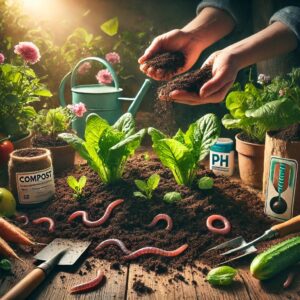1. Introduction: The Importance of Healthy Soil
Soil is the foundation of life for plants, and its health directly impacts the vitality of gardens, farms, and ecosystems. Healthy soil supports stronger plants, improves food production, and reduces the need for synthetic inputs. Without proper care, soil can become depleted of essential nutrients, leading to poor plant growth and environmental degradation. But there are simple, practical ways to restore and improve soil health.
1.1 What is Soil Health?
Soil health refers to the soil’s ability to function as a living ecosystem that sustains plants, animals, and humans. This includes maintaining a balance of nutrients, moisture, and microbial activity. Healthy soil is fertile, well-structured, and rich in organic matter.
1.2 Why is Soil Improvement Crucial for Plants?
Plants rely on soil for nutrients, water, and support. Improving soil ensures that plants get the nutrients they need while also retaining moisture and resisting erosion. Healthy soil also reduces the need for chemical fertilizers, creating a more sustainable environment.
2. Understanding the Composition of Soil
Before embarking on soil improvement, it’s essential to understand its composition. Soil is a mix of minerals, organic matter, and microorganisms, and these components determine its texture, structure, and fertility.
2.1 Types of Soil: Sand, Silt, Clay, and Loam
Soils are typically categorized into four main types:
- Sand: Drains well but lacks nutrient retention.
- Silt: Retains moisture and nutrients but is prone to compaction.
- Clay: Holds water and nutrients but has poor drainage.
- Loam: A balanced mix, loam is considered ideal for gardening.
2.2 Soil Structure and Its Role in Plant Growth
Soil structure refers to the arrangement of soil particles. Good soil structure allows air, water, and roots to move freely, supporting healthy plant growth. Compacted or poorly structured soil, on the other hand, restricts root development and limits the soil’s ability to absorb water.
3. Benefits of Improving Your Soil
Improving your soil has multiple long-term benefits for plants, the environment, and even water conservation.
3.1 Improved Nutrient Availability
Well-improved soil allows plants to access vital nutrients such as nitrogen, phosphorus, and potassium more easily.
3.2 Enhanced Water Retention
Soils rich in organic matter retain water more effectively, which is crucial in drought-prone regions. Improved water retention also means you’ll need to water less frequently, saving both water and time.
3.3 Stronger Root Development
Healthy soil encourages deep root systems, which makes plants more resilient to environmental stressors like drought, wind, and disease.
$ads={1}
4. Testing Your Soil: The First Step to Improvement
The first step in improving your soil is knowing what it lacks. Soil tests can tell you the pH level, nutrient content, and overall composition.
4.1 Simple At-Home Soil Test Methods
There are several DIY tests you can do at home to analyze your soil’s texture and pH. One common method is the soil jar test, where soil is mixed with water to observe its layers. You can also use a pH strip to check the acidity or alkalinity.
4.2 Understanding Soil pH and Its Importance
Soil pH affects how well plants absorb nutrients. Most plants prefer a slightly acidic to neutral pH (around 6.0 to 7.0). Soils that are too acidic or alkaline can prevent plants from taking up essential nutrients, leading to poor growth.
4.3 Nutrient Deficiency Signs in Soil
Soil lacking in nutrients will show signs in the plants growing in it. Common deficiencies include:
- Yellowing leaves (nitrogen deficiency).
- Purple leaves (phosphorus deficiency).
- Brown or scorched edges (potassium deficiency).FAQs: Simple Ways to Improve Your Soil
What is the easiest way to improve soil quickly?
Adding compost or organic matter is one of the fastest ways to enrich soil.
How can I test my soil at home?
You can conduct a soil jar test for texture or use pH strips to check acidity.
Can cover crops improve soil health?
Yes, cover crops can prevent erosion, add nutrients, and improve soil structure.
How does mulching help soil?
Mulching conserves moisture, suppresses weeds, and adds organic matter as it breaks down.
What is the best type of soil for gardening?
Loam soil, which is a balanced mix of sand, silt, and clay, is ideal for gardening.
How often should I add compost to my garden?
Adding compost once or twice a year is typically sufficient to maintain healthy soil.


